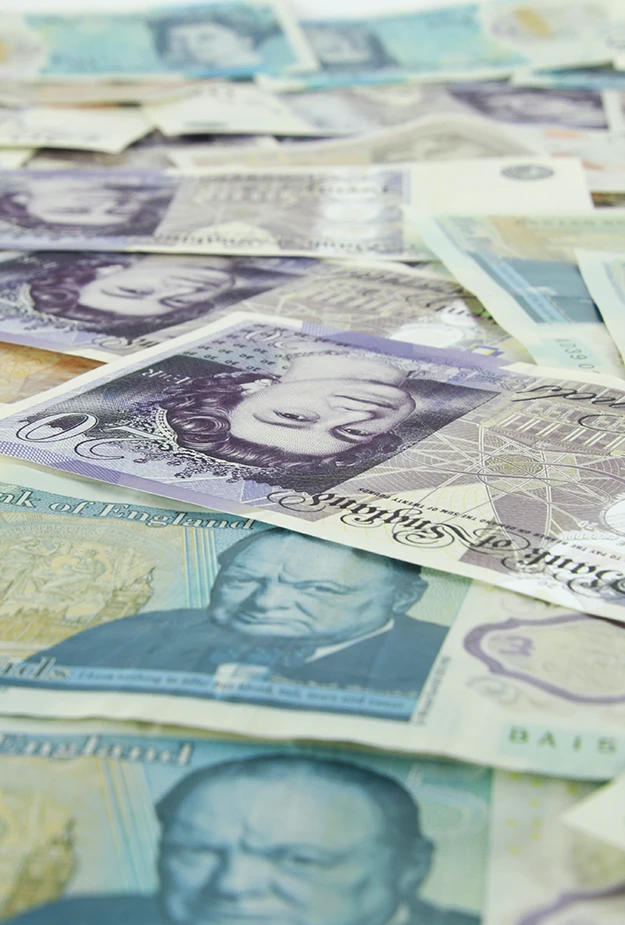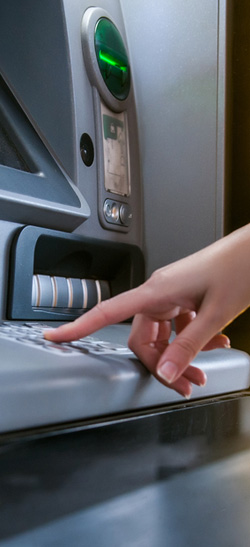Unlike the old paper notes, UK banknotes are made from polymer issued by the Bank of England. This gives them their unique feel and design.
Polymer is a type of highly flexible and thin plastic material that has many advantages – such as security, sustainability, and ensuring that the government stays one step ahead of counterfeiters.
However, polymer banknotes have an array of other benefits. So, let’s explore why exactly the UK transitioned to polymer banknotes, its unique features, and its environmental impact.
The Transition from Paper to Polymer Banknotes
The move from paper to polymer banknotes marked a significant shift in UK currency.
The Bank of England issued the first polymer £5 note in September 2016, followed by the polymer £10 note in the second half of 2017. The polymer £20 note was introduced in 2020, and the polymer £50 note in 2021. To this day, the Bank of England has printed almost 6 billion polymer banknotes.
The strategic decision to switch to polymer banknotes was driven by a need to increase the currency’s durability and enhance security. This improved printing technique meant that banknote designs were more complex and harder to copy.
Public polling indicated that 87% of respondents were in favour of switching to polymer banknotes, and public confidence in England banknotes has remained high despite changes to their material.
The majority of respondents agree that new banknotes are harder to damage compared to older paper notes.
The benefits of polymer banknote have been seen across the globe – with other countries, such as Canada, New Zealand, and Australia, having also adopted the currency.
But why polymer?
What is Polymer & Why Use It?
Polymers are a very long chain of molecules that occur naturally, but they can also be manufactured – in this instance, they are called synthetic polymers (also referred to as plastics).
Polymer banknotes are made from a synthetic polymer called biaxially oriented polypropylene (BOPP), which has many useful properties. These include being strong and hard-wearing yet highly flexible – making it the perfect material for our polymer banknotes.
The first polymer banknote was issued in Australia in 1988. Romania was then the first country in Europe to issue a plastic note in 1999 and became the third country after Australia and New Zealand to fully convert to polymer by 2003.
Unlike paper banknotes, which are made using sophisticated and traditional methods, a polymer banknote is made using a layered printing process.
The process starts with a polymer sheet, where each element of the note is added until it is complete. It is then cut and tested for imperfections. This process also includes heating polymer pallets and blowing them into a big bubble of liquid polymer.
Polymer banknotes are made from cutting-edge materials and methods, so this shift from the outdated cotton or linen mix introduces a unique blend of durability and protection.
However, there are many other benefits that polymer banknotes have to offer.
Increased Durability
One of the main reasons for the switch from paper to polymer banknotes is that polymer banknotes last significantly longer than paper notes.
Polymer banknotes are expected to last at least 2.5 times longer than paper equivalents. This is because they are designed in a way which can withstand the wear and tear of daily use.
The new polymer notes are robust, having been designed to resist chemicals, dirt, and moisture to ensure that they remain in circulation longer.
Enhanced Security
Polymer banknotes are inclusive of enhanced security features, leading to a reduction in counterfeiting levels. For example, watermarks and micro-lettering are traditional security features used in banknotes.
The new polymer material used in banknotes is inherently more secure than paper, now including additional features such as holograms, transparent windows, raised print, and colour-shifting inks. Windowed metallic threads are also incorporated into banknotes as a security feature. All these unique features are difficult to replicate.
The smooth surface of the polymer also allows for sharper printing and more detailed designs. High-quality print lines and colours help distinguish genuine banknotes from counterfeits.
Environmental Considerations
A life-cycle analysis shows that polymer banknotes have a reduced environmental impact compared to paper banknotes. For example, the carbon footprint of a £5 polymer banknote is 16% lower than that of a paper £5 note, making a polymer banknote more environmentally friendly.
Thanks to their increased durability, polymer banknotes need to be replaced a lot less often, which reduces overall waste and resource consumption.
At the end of their lifespan, polymer banknotes are recyclable and can be repurposed into other useful plastic items, such as plant pots, building materials or storage boxes. This makes the polymer note a far more sustainable choice.
Accessibility
The Bank of England has also designed the polymer banknote with accessibility in mind.
Polymer banknotes include features that help visually impaired consumers distinguish between denominations. For instance, the polymer banknotes have tiered sizing, bold lettering, and braille markings.
The £10, £20, and £50 notes all have corresponding raised dots in varying positions on the note to aid users in identifying the denominations, except the £5 note, which is distinguishable by its lack of raised dots.
These features ensure that polymer notes are inclusive and practical for all users.
Cleaner
Polymer banknotes are much more hygienic than their paper counterparts, as health researchers have found that plastic banknotes are 3x cleaner than paper ones and, therefore harbour fewer germs.
The bacterium on human hands seems less capable of sticking to plastic notes in comparison to the old cotton banknotes.
Polymer banknotes have an additional advantage as their smooth, non-porous surface that resists dirt, moisture, and bacteria makes it easier for them to be cleaned if needed.
Which is equally important in reducing the spread of illness through frequently handled currency.
Unique Features of Polymer Banknotes
Designing a new banknote series involves several key stages, including scientific research, accessibility considerations, and the production of design concepts.
This intricate research process is conducted as banknote designs are symbolic representations of national pride and identity, commemorating significant individuals or milestones.
Examples of significant individuals and milestones celebrated on UK polymer banknotes include Winston Churchill on the £5 note, commemorating his leadership during World War II, and Jane Austen on the £10 note, recognising her literary contributions. Additionally, the £20 note features the artist J.M.W. Turner, honouring his impact on British art, while the £50 note celebrates the pioneering mathematician and computer scientist Alan Turing.
Concept designs for banknotes provide an early sketch of how characters and design elements will be featured. For example, the character that appears on the back of each banknote is the main way to differentiate all the denominations, and the visual design of banknotes incorporates images inspired by the character’s achievements.
It is such an important decision that the character selection process for banknotes has evolved to include public nominations and a selection committee.
In the end, the finished design must be feasible for large-scale production to ensure high quality.
In addition to the process of creating and designing a new banknote, the new polymer banknotes include several other distinctive features which set them even further apart from their predecessors.
See Through Windows
Transparent windows are one of the more distinctive features of the new banknotes.
They are not only a new modern design but contribute significantly to the enhanced security features.
They are a unique element which is very difficult to replicate with traditional printing methods and continue to deter counterfeit notes.
The intricate patterns and images within the see-through windows provide an additional layer of authenticity and contribute to the overall security of the currency. For example, on the front of the new polymer £5 and £10 banknotes, there is a clearly defined Queen Elizabeth II image featured in the transparent window, alongside the numerical value of the note.
Raised Print
The raised dots incorporated into the new banknotes play a key role in improving both accessibility and security.
On the front of the £10 polymer note, two groups of raised dots are located in the top left corner. This tactile element helps users who are blind or have partial sight to recognise the note’s value while also minimising the slippery texture of the new banknotes.
Beyond accessibility, the distinctive feature is also difficult to reproduce accurately, so it is yet another subtle but effective security measure.
Holographic Foil
The holographic foil is one of the standout features of the new banknote.
The reflective material creates a dynamic and multi-dimensional effect that shifts in colour and design when the banknote is looked at from different angles under light.
Holographic foil is another useful and sophisticated security measure. The intricate nature of the foil makes it very challenging to replicate as it requires advanced manufacturing techniques, as well as precise alignment, to copy the art accurately.
Also, they are embedded in key areas of the note, such as around the transparent windows or alongside other printed features. This helps authentic notes be quickly and easily identified by the public and machines.
The shimmering and eye-catching quality of the holographic foil gives the banknotes a more modern and premium appearance.
UV Features
UV features are also a unique attribute of the new polymer note and are visible with a suitable UV lamp that emits light around 365 nanometres. However, LED lights, such as key-fob style detectors, are not suitable.
When you look at the notes under ultra-violet (UV) light, you will see there are areas of the note that appear as a single colour in daylight but as two separate colours that glow. This is another feature that contributes to the security and authenticity of the new banknotes.
Environmental Impact & Recycling of Polymer Banknotes
Polymer banknotes are made of plastic. However, they last significantly longer and reduce the need for frequent replacement while lowering overall production demands.
The extended life span of the polymer banknotes helps conserve resources and minimises waste over time. Additionally, no trees are being cut down for the new banknotes in comparison to the paper ones.
When polymer banknotes do finally reach the end of their life cycle, they are not simply discarded. Instead, they are recycled into a range of everyday products, which ensures that the materials used to create the notes are always repurposed sustainably.
Producing polymer notes is also shown to have a smaller carbon footprint compared to paper notes over their full lifecycle, thanks to the reduced manufacturing and replacement needs. The combination of longevity, recyclability and lower environmental impact reflects the more sustainable approach of the polymer banknote.
Unfit Polymer Banknotes
Unfit polymer banknotes are notes that have become damaged, torn, or worn to the point that they no longer meet the required standards for circulation.
These notes are systematically removed from the cash cycle by the issuing authority and are then either destroyed or recycled through specialised processes to minimise environmental impact.
The Future of Banknote Materials
With technology and sustainability playing a big role in our lives, we can expect some interesting changes in the materials used for banknotes.
Researchers and central banks are on the lookout for ways to enhance the security, durability, and eco-friendliness of our currency. New materials like biodegradable polymers and advanced composites might help lessen the environmental footprint of making and recycling money.
Digital currency is changing the discussion, leading to questions about the importance of physical money in a world that is moving away from cash. Yet, in countries where cash is still important, the emphasis will be on enhancing materials to address the growing need for security, durability, and eco-friendliness.
The new generation of banknotes may be smarter, more eco-friendly, and tougher due to improvements in printing technology and materials science. This will help them stay a reliable and useful form of money in the future.
However, there are also technological advancements surrounding physical cash.
What is CashTech?
Providers like Paycomplete are specialists in physical money and its handling, from smart hardware to leading-edge software.
CashTech is all about blending technology with cash handling to make things smoother, safer, and easier in our digital age. This covers innovations such as smart ATMs, cash recycling machines, and high-tech counterfeit detection tools.
CashTech keeps physical money in the game, even as digital payments take over. By optimising cash management and using the latest tech, CashTech connects the old-school cash system with modern payment methods, making sure cash stays important in the global economy.
Conclusion
Polymer banknotes have revolutionised UK currency, offering enhanced durability, security, and sustainability compared to their paper predecessors. Their innovative design and materials have not only increased public confidence but also improved accessibility and hygiene.
As the future of banknotes continues to evolve with new materials and digital innovations, CashTech plays a crucial role in modern cash management.
At PayComplete, we specialise in cutting-edge CashTech solutions that streamline cash handling for businesses worldwide. Explore how our technology can optimise your cash operations – contact us today!

Related Posts









